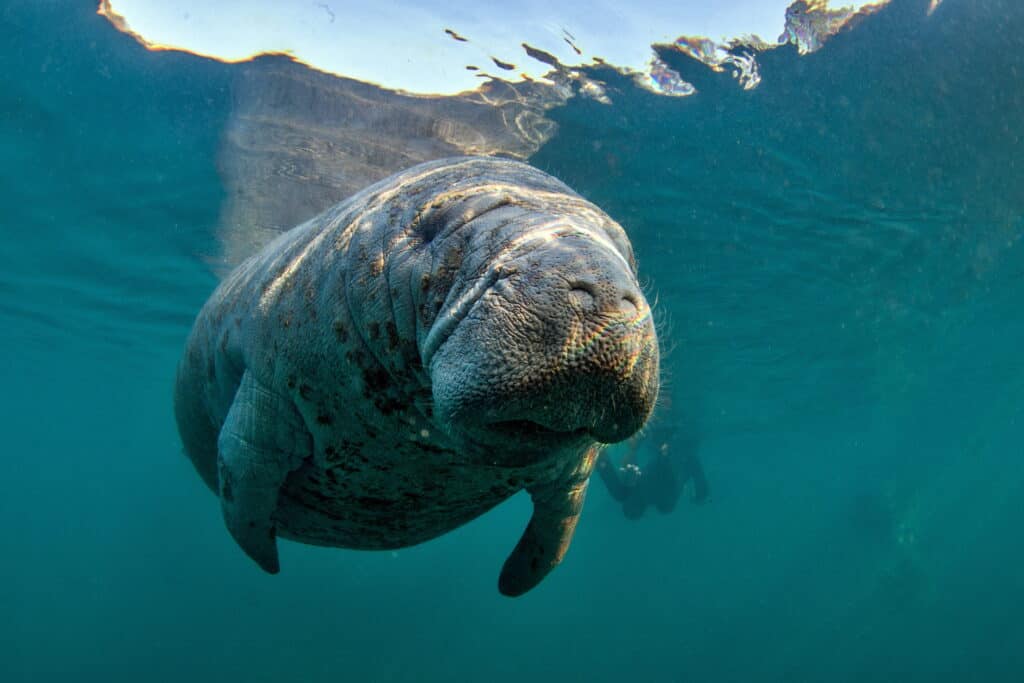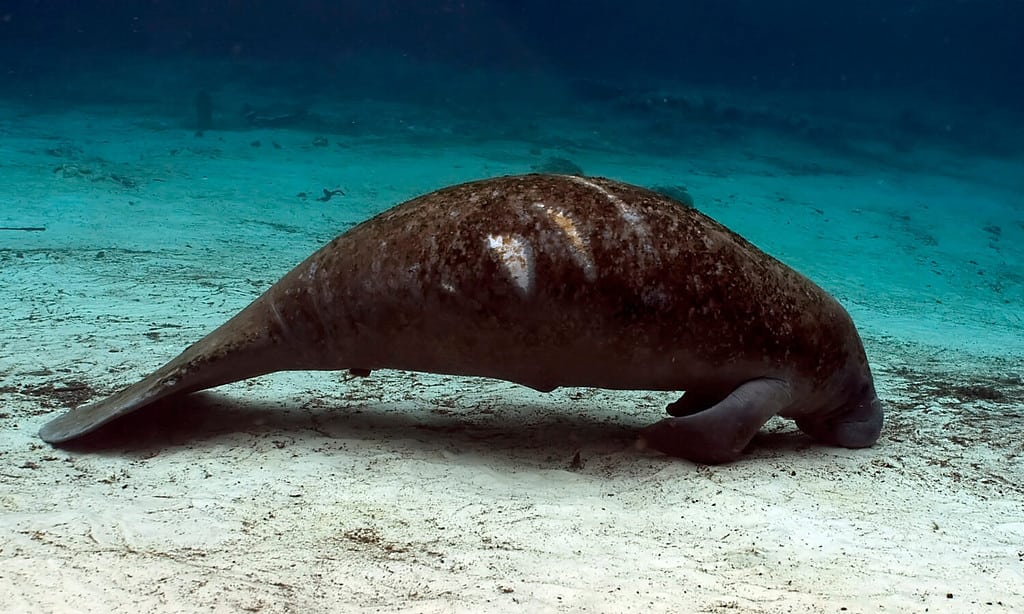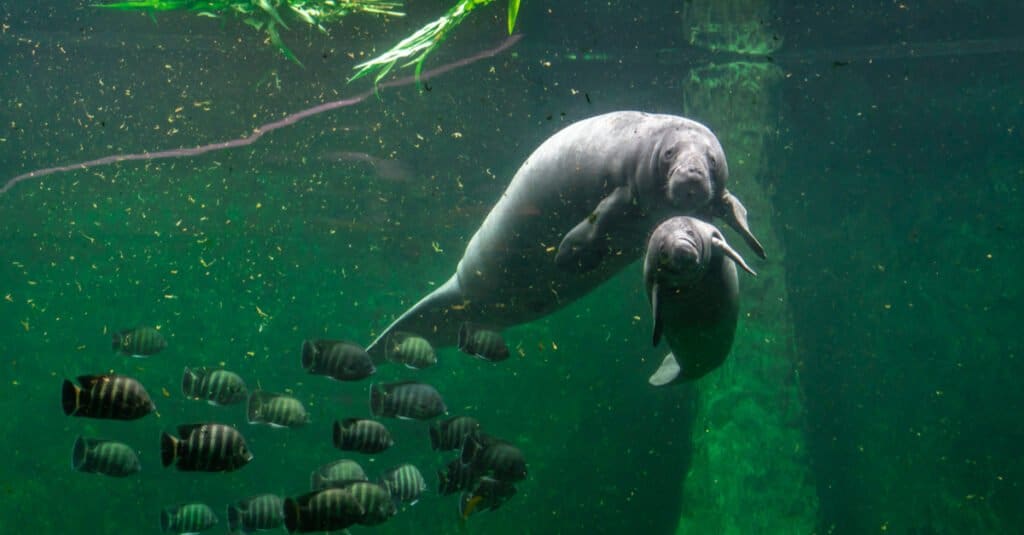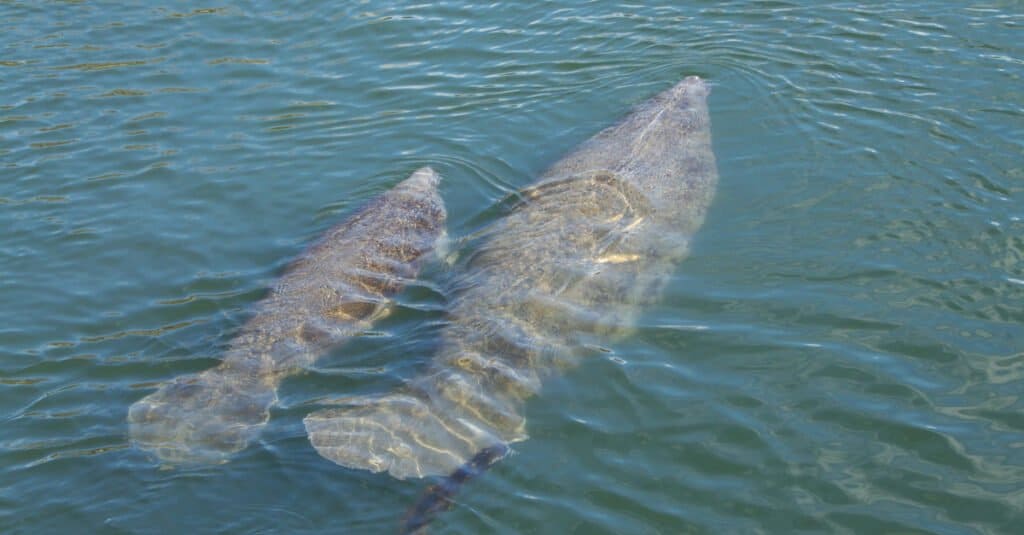The manatee is easily one of the most unique creatures in the animal kingdom. These marine mammals are gentle giants, making their way through oceans and seas with little fear of predators. Scientists recognize three extant species, all within the genus Trichechus: the Amazonian manatee (Trichechus inunguis), the West Indian manatee (Trichechus manatus), and the West African manatee (Trichechus senegalensis). They may not look it with their unwieldy bodies, but these remarkable mammals are highly capable swimmers. Discover how fast manatees can swim and other fascinating facts!

There are three extant species of manatees: Amazonian, West Indian, and West African.
©Tomas Kotouc/Shutterstock.com
How Fast Can Manatees Swim?
Manatees swim at speeds of up to 20 miles per hour. However, they typically move much more slowly than this, around three to five miles per hour. Despite their bulky and unathletic appearance, they are surprisingly graceful swimmers.
The reason for the manatee’s slow, lumbering speed may have to do with their metabolism. Because of their massive size, they must consume huge quantities of plant matter every day to survive. A typical manatee ingests between four and nine percent of its body weight in aquatic vegetation, though some consume even more. Given that manatees can weigh over 3,500 pounds, the weight of a single manatee’s daily meals may be well in excess of 100 pounds! Due to the enormous effort required to find suitable nutrition, manatees spend a significant portion of their day – up to eight hours – feeding on plant life. This means they don’t have a lot of energy to invest in energetic movement. Moving slowly helps them conserve energy.
Other Fascinating Facts About Manatees
Manatees are fascinating for a host of reasons besides their swimming speed! Read on to discover other interesting facts about these marine mammals.
1. Manatees Are Extremely Friendly and Sociable
Manatees are highly sociable and inclined to be friendly to humans swimming nearby. These gentle giants have few natural predators, which probably contributes to their trusting nature. Due to their affable nature, they are unlikely to cause harm to swimmers despite their massive size.
It may be tempting to interact with the curious manatee approaching you in the water. But touching or feeding these creatures can cause them to lose their fear of humans and alter their behavior in the wild. This could lead to manatees approaching boats or other manmade objects in the water, which poses the risk of injury. In some cases, as in Florida, physical contact with manatees is illegal.

Manatees are sociable creatures, but their curiosity about humans and boats can cause them harm.
©gary powell/Shutterstock.com
2. Manatees Are Intelligent
Although scientists lack comprehensive knowledge of manatee cognition, there is evidence that it is highly complex. Not only are manatees capable of learning new skills, but they also show evidence of long-term memory. In addition to this, they perceive and communicate with their environment in a number of ways. These include visual, acoustic, and tactical modalities.
To communicate with each other, manatees whistle, chirp, squeak, or grunt. This is especially common between cows and their calves. However, these sounds do not appear to be a means of navigation.
3. Manatees Are Related to Elephants
Although manatees are also called “sea cows,” they are actually related to elephants. Manatees belong to the order Sirenia; along with Proboscidea (elephants, mastodons, and woolly mammoths) and Embrithopoda (an order of extinct mammals), this order belongs to the clade Tethytheria. These three orders likely share a common ancestor. Manatees and elephants share a number of unique adaptations, including hind molar progression and prehensile lips.
4. Manatees Have No Legs
Because they reside solely in the water, manatee have no use for legs. Instead, they have a set of pectoral flippers that they use for locomotion. While feeding, they use these flippers somewhat like legs and arms to “walk” along the bottom as well as to push food toward their mouths. They also have a broad, paddle-shaped tail that allows them to propel themselves through the water.

Instead of legs, manatees have two pectoral flippers and a broad tail.
©Lukasz Machowczyk/Shutterstock.com
5. Manatees Only Have Six Bones in Their Necks
Manatees are unusual mammals in that they have only six cervical vertebrae in their necks. Most mammals (including humans) have seven, which allows them to look left and right. To look to either side, manatees have to use their flippers to turn their entire bodies.
6. Manatees Keep Replacing Their Teeth Their Whole Lives
Much like elephants, manatees replace their teeth constantly their whole lives. This adaptation is in response to the weak enamel on their molars, which has difficulty resisting the abrading effect of harsh vegetation. As a result, manatees must replace their molars periodically. Over time, worn molars fall out and new molars grow in at the back of the row. As if on a conveyor belt, they slowly move forward to take the place of the abraded molars. This is called “hind molar progression” or “marching molars.” Interestingly, manatees have only one kind of tooth: hind molars. They lack incisors or canines, which would more typically be present in a carnivore.
7. Manatees Spend Up to 12 Hours a Day Resting
The manatee’s massive size and intimidating nutritional requirements mean it must conserve energy whenever possible. To achieve this, it spends up to 12 hours of its day resting or sleeping beneath the surface. Although it can’t breathe underwater, it is capable of holding its breath for up to 20 minutes at a time (however, it resurfaces every three to four minutes while swimming). To survive during these long naps, it periodically resurfaces for air, then descends once more into the water.
This raises an interesting question: if the manatee is asleep, how can it keep resurfacing? Like many marine animals, manatees exhibit unihemispheric sleep. This means that while half of the brain rests, the other half remains alert and ready to react. This handy adaptation makes it possible for marine animals to rest while underwater. By contrast, humans exhibit bihemispheric sleep.

Manatees spend up to 12 hours a day resting or sleeping, surfacing only to breathe.
©romarti/Shutterstock.com
8. Manatees Have Unusually Long Intestines
The manatee is also unique for having unusually long intestines. Remarkably, its digestive tract extends up to 150 feet in length! Although the manatee’s stomach is simple, its cecum is large, helping it digest the vast amount of plant matter passing through its system.
9. Manatees Have Prehensile Lips
Another fascinating feature of the manatee is its prehensile lips. These extremely flexible lips are able to grasp vegetation and pull it into their mouths. Each side is capable of operating independently of the other. Manatees also use their lips for social interaction and communication.
Conclusion
Manatees are fascinating creatures with a number of unique adaptions, which include a swimming speed of up to 20 miles per hour and the ability to hold their breath for up to 20 minutes. Although their friendly demeanor may be inviting to swimmers, it’s best to leave these creatures alone for their own protection.
The photo featured at the top of this post is © Ramos Keith, U.S. Fish and Wildlife Service / public domain – License / Original
Thank you for reading! Have some feedback for us? Contact the AZ Animals editorial team.






